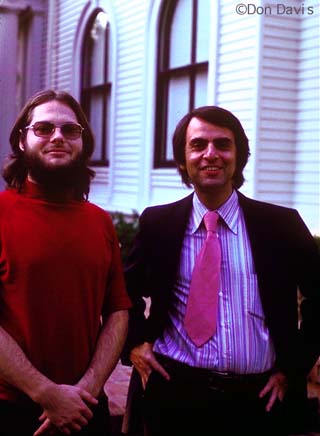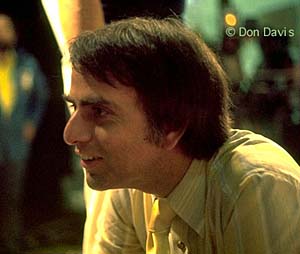
Carl Sagan
some recollections

Seeing a dream come true. Carl viewing the first panorama from the surface of Mars at JPL the evening of July 20, 1976.
Carl Sagan died 12:32 AM PST December
20th, 1996 at the Fred Hutchinson Cancer Center in Seattle, of
pneumonia after a 2 year battle with Myelodysplasia, with wife
Ann Druyan and other family members at his side.
He will never be replaced, his space related
activities crossed not only the substantial gulf between scientist
and public educator, his career also spanned the transformation
of the solar System from tiny telescopic objects to places seen
and understood from human and mechanical experience.
The unveiling of the reality of our cosmic situation
was part of his life, and spreading the appreciation of these
truths and their implications was another aspect of his life.
Along with all this he made sure he had a private life with his
family.
It's good to know how much he lived to see unveiled during his
lifetime, yet I grieve for the fact that he never saw the completion
of 'Contact', which be worked so hard to realize.
With each new landscape we see on the surface of Mars
and every future inventory of a world's wonders we accomplish,
I will wish Carl could be seeing this.
On his last appearance on Nightline on December 4th,
he did look haggard, yet at the end of the interview when asked
to express something to us, he poured out the same wondrous enthusiasm
we will always know him for.
To many of the space artists Carl Sagan was known
as among the greatest patrons of our art. His article in the December
1967 National Geographic on Mars and exobiology included a painting
of an imaginary life form adapted to Martian conditions. Most
of his books and magazine articles contained work by artists whose
perceived strengths were suited to his given subject. He would
see any subtleties one placed in a painting pertaining to subjects
he had knowledge of. His own collection of space art was to ultimately
cover the era of Solar System studies beginning with originals
by Chesley Bonestell from The Conquest of Space, the pivotal Ley-Von
Braun-Bonestell book, to many of the covers done for his own books
done in the Space Age and many other works by various artists.
I first met Carl in the summer of 1972, through
the efforts of Paul Fox, who worked at the Stanford Artificial
Intelligence Laboratory where I hung out with people I knew there.
I visited a commune known as 'The Land' atop the hills overlooking
the Stanford campus, and brought with me a new painting of Mars
and Phobos based on mariner 9 data. I partied and talked, then
made my way to the end of one of the rooms where I saw Carl peering
very closely at that painting. A short time later, we were introduced,
and he complimented me on my work. He was editor of Icarus at
that time, and when I reminded him of the Lunar evolution paintings
recently appearing in a paper by Don Wilhelms, my supervisor at
the U.S. Geological Survey, Carl related how he worked especially
hard to reproduce them as well as he could. I remember asking
him if he ever wanted to write science fiction, and he said that
some of his colleagues thought that was what he was doing now!
He gave a slide show filled with gorgeous imagery, of which he
always had the highest quality examples.
I next saw him on the Apollo 17 launch cruise, where
he was a guest speaker. I ran the slide dissolve unit during his
lecture, sweating out the process of timing the images with his
speaking. Rick Sternbach was with me on that cruise, where we
saw the Apollo 17 night launch, then visited the mammoth Aricibo
radio telescope in Puerto Rico.
The next time Carl and I crossed paths was a committee
we were invited to in 1974 at NASA Headquarters to choose the
winner among the entries in a Viking emblem design contest in
which many high school students submitted drawings, the winner
of which was flown on the Mars landers.
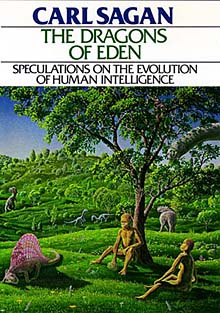
The first use of my work in Carl's publications
was for the cover of 'The Dragons Of Eden', that was an oil painting
on Masonite. Over the years my work was to appear occasionally
in his books and Parade magazine articles. He was the most demanding
yet the most perceptive of anyone I had ever done a painting for.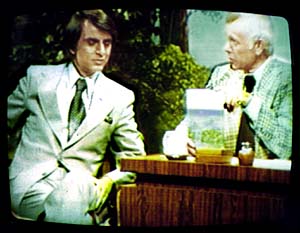
Left: My front cover for 'the dragons Of Eden
Right: Carl on the 'Tonight' show with Johnny Carson holding a copy of the book.
The evening of the Viking 1 landing
on July 20 1976 at jet propulsion laboratory was perhaps the greatest
space related cultural event since the end of the Apollo era.
The JPL press area became the site of the first of the 'gathering
of the tribes' which took place during this and the later Voyager
missions. Many of the space related professionals and artists
met and networked at these events. Among the celebrities and science
fiction authors present at the Viking 1 landing was Carl, drinking
in the sight of the first Martian landscape ever seen. 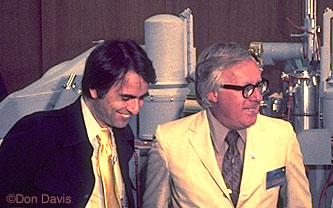
Left: Two aspects of our fascination with Mars are brought together the night of the Viking 1 landing, Carl Sagan the scientist and Ray Bradbury the science fiction writer. Both wrote of the 'Red Planet' in very different ways. A NASA painting I did of the landing showing Mars with a blue sky was used as the background for the press badges (below)
During that evening I was interviewed
by Jon Lomberg as my voice failed, as he collected impressions
for a Canadian radio program. Some of his interviews, and one
of my paintings, were used in the 'Visions of Mars' CD-ROM which
sadly will probably have to wait to get to Mars until it is carried
there by humans in whatever digital format they will use then.
Jon Lomberg, longtime friend of Carl and a painter
of SETI concepts among other things, graced many of Sagan's books
from 'The Cosmic Connection' onwards. Among his collaborations
with Sagan was the assisting in sifting through what sounds warranted
including on the videodisk to be carried aboard the Voyager spacecraft.
Lomberg's seeking out other artists in the space field
was to create the pool of talent to be assembled for the PBS show
'Cosmos'.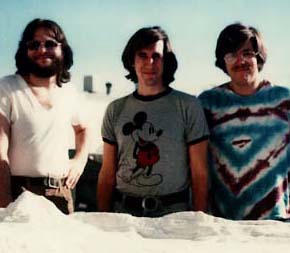
The introduction of several space artists to television
show production was a pivotal step in many of their careers, and
although the heartaches and tortures of the emergencies cropping
up during the production were particularly brutal, the results
were ultimately beneficial to all involved. Some of the artists
were awarded Emmys for visual effects for their work in 'Cosmos'
Right: Polaroid made in 1979 while working on the first model for Cosmos. Left to right: Don Davis, Jon Lomberg, Rick Sternbach.
Below, Left to right: Adolf Schaller, Don Davis, John Allison, Jon Lomberg, Brown. Many of the original negatives of the visual effects are in the boxes along the wall.
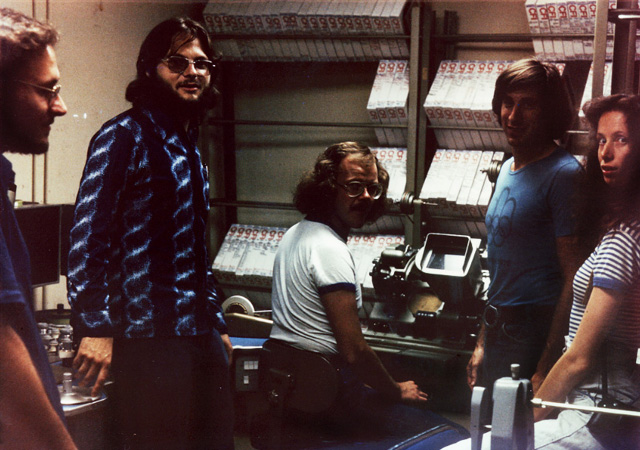
To name but a few of the artists
involved, Rick Sternbach went on to become a pivotal conceptual
artist and designer for Star Trek's various television incarnations.
Adolf Schaller continued publishing at a modest but steady pace
his fine paintings and has a book out now about Extraterrestrials.
John Allison was to remain active in TV and later film visual
effects. Jon Lomberg has maintained a continuing presence in many
realms of creative endeavor in and out of the space field. In
a real sense, Carl Sagan had a pivotal effect in the vitality
and development of space art through the Cosmos experience.
Later the Planetary Society and it's magazine was
to be a continuing publisher of high quality information about
planetary exploration, and the Search for Extraterrestrial Intelligence,
another of Carl's great passions.
At the ceremony at Goldstone on Columbus Day 1992 inaugurating
the High Resolution Microwave Survey, carrying listening devices
to search for signals from other civilizations, Carl gave an especially
memorable speech, then sat and listened with other dignitaries
as the attempts to contact the radio telescope crew in Aricibo
collapsed into hopeless static, feedback, and dial tones. I saw
him through my video camera viewfinder gallantly suppressing the
impulse to burst out laughing, probably thinking about the irony
of trying to communicate among the stars but not being able to
reach another spot in the same world!
Sagan sought to warn the human race when he saw danger on the
road ahead.
He participated in a demonstration
at the Nevada Test site, to be joyously arrested with others trying
to buck the destructive trends of the times. So much about him
I know so little of, that is for others to illuminate.
Along with others who had the pleasure of working with him
over the years, I wish I could have known him more and I treasure
the memories of what experiences and endeavors we shared.
Don Davis
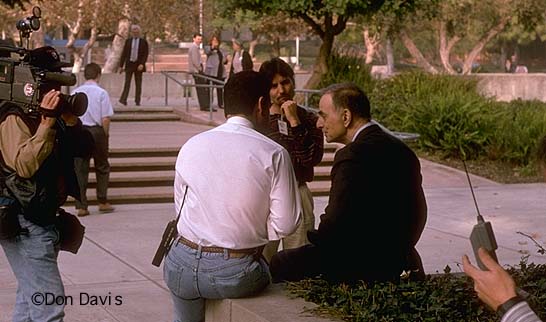
Above: Sagan at JPL December 7, 1995 during the Galileo Jupiter probe arrival.
Below: Carl visiting my home at the Atherton Mansion in 1975 while I was painting the cover for his book 'The Dragons Of Eden'.
